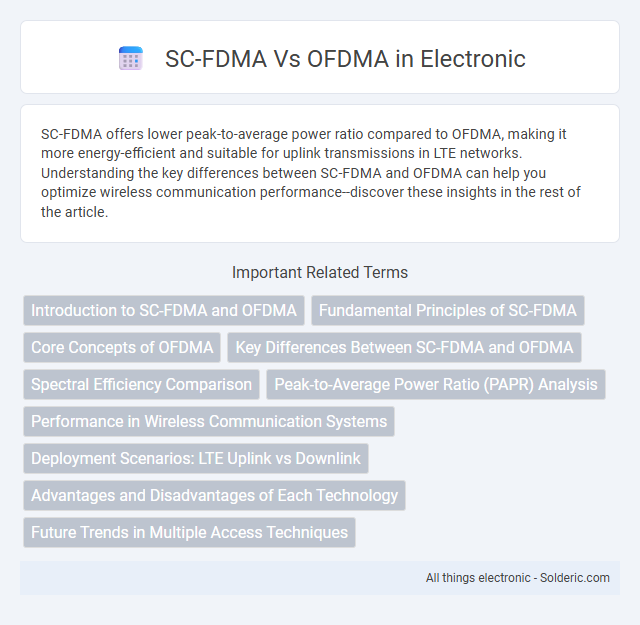SC-FDMA offers lower peak-to-average power ratio compared to OFDMA, making it more energy-efficient and suitable for uplink transmissions in LTE networks. Understanding the key differences between SC-FDMA and OFDMA can help you optimize wireless communication performance--discover these insights in the rest of the article.
Comparison Table
| Feature | SC-FDMA | OFDMA |
|---|---|---|
| Full Name | Single Carrier Frequency Division Multiple Access | Orthogonal Frequency Division Multiple Access |
| Usage | LTE Uplink | LTE Downlink, WiMAX, 5G NR |
| Peak-to-Average Power Ratio (PAPR) | Low | High |
| Multiplexing Type | Single Carrier | Multi-Carrier |
| Complexity | Lower transmitter complexity | Higher transmitter complexity |
| Power Efficiency | High | Lower |
| Frequency Domain Equalization | Uses DFT precoding before OFDM modulation | Direct OFDM modulation |
| Interference Management | Less flexible | More flexible |
| Latency | Lower latency | Higher latency |
| Typical Applications | Uplink in LTE to reduce power consumption | Downlink in LTE, Wi-Fi, 5G NR services |
Introduction to SC-FDMA and OFDMA
SC-FDMA (Single Carrier Frequency Division Multiple Access) and OFDMA (Orthogonal Frequency Division Multiple Access) are advanced multi-user modulation techniques used in wireless communication systems. SC-FDMA is favored in uplink transmissions due to its low Peak-to-Average Power Ratio (PAPR), which enhances power efficiency in mobile devices. OFDMA, widely implemented in downlink scenarios, excels in spectral efficiency and supports high data rates by dividing the channel into multiple orthogonal subcarriers for simultaneous user access.
Fundamental Principles of SC-FDMA
SC-FDMA operates on the principle of single-carrier transmission combined with frequency domain equalization, which significantly reduces the Peak-to-Average Power Ratio (PAPR) compared to OFDMA. This fundamental approach ensures better power efficiency and lower signal distortion, making SC-FDMA particularly advantageous for uplink communication in LTE networks. Your device benefits from enhanced battery life and improved transmission quality due to SC-FDMA's streamlined modulation technique.
Core Concepts of OFDMA
OFDMA (Orthogonal Frequency-Division Multiple Access) divides the total bandwidth into multiple orthogonal subcarriers, allowing simultaneous data transmission to multiple users by assigning distinct subcarrier groups. It enhances spectral efficiency and reduces interference through precise frequency allocation, making it suitable for high-speed wireless networks like LTE and Wi-Fi. Understanding OFDMA's subcarrier orthogonality and user multiplexing is essential for optimizing Your network's throughput and resource allocation.
Key Differences Between SC-FDMA and OFDMA
SC-FDMA uses single-carrier modulation, offering lower peak-to-average power ratio (PAPR) suited for uplink transmissions in LTE, while OFDMA employs multi-carrier modulation with higher spectral efficiency ideal for downlink. SC-FDMA's pre-coding step reduces power amplifier complexity, making it energy-efficient compared to OFDMA's direct subcarrier mapping. OFDMA supports flexible resource allocation and better multi-user diversity, contrasting SC-FDMA's simpler frequency-domain allocation scheme.
Spectral Efficiency Comparison
SC-FDMA offers improved spectral efficiency in uplink transmissions due to its single-carrier structure, which reduces the peak-to-average power ratio (PAPR) and enhances power amplifier efficiency. OFDMA, widely used in downlink scenarios, provides flexible resource allocation and supports multiple users simultaneously by dividing the spectrum into orthogonal subcarriers, optimizing spectral usage in multi-user environments. When comparing spectral efficiency, SC-FDMA tends to be more power efficient with moderately high spectral efficiency, while OFDMA achieves higher spectral efficiency through dynamic subcarrier assignment and better multi-user multiplexing capabilities.
Peak-to-Average Power Ratio (PAPR) Analysis
SC-FDMA exhibits a significantly lower Peak-to-Average Power Ratio (PAPR) compared to OFDMA, making it more power-efficient for uplink transmission in mobile communication systems. Your device benefits from SC-FDMA's reduced PAPR by achieving longer battery life and improved signal quality under nonlinear power amplification. In contrast, OFDMA's higher PAPR increases power amplifier complexity and energy consumption, which can degrade overall system performance.
Performance in Wireless Communication Systems
SC-FDMA offers lower Peak-to-Average Power Ratio (PAPR), enhancing power efficiency and reducing signal distortion in uplink transmissions, which is crucial for battery-powered mobile devices. OFDMA provides superior spectral efficiency and flexible resource allocation, enabling higher data rates and better multi-user handling in downlink scenarios. The choice between SC-FDMA and OFDMA impacts link reliability, energy consumption, and overall system throughput in wireless communication networks.
Deployment Scenarios: LTE Uplink vs Downlink
SC-FDMA is primarily deployed in LTE uplink due to its low peak-to-average power ratio (PAPR), which improves battery efficiency and reduces power amplifier complexity in user equipment. OFDMA is favored for LTE downlink because it efficiently supports multiuser diversity and flexible subcarrier allocation, enabling robust data throughput in base station transmissions. The differing PAPR characteristics and resource allocation capabilities fundamentally determine their roles in LTE's uplink and downlink deployment scenarios.
Advantages and Disadvantages of Each Technology
SC-FDMA offers lower Peak-to-Average Power Ratio (PAPR), making it more power-efficient and ideal for uplink transmissions in mobile devices, while OFDMA supports higher spectral efficiency and flexible resource allocation, benefiting downlink scenarios. SC-FDMA's lower complexity in transmitter design reduces power consumption but may suffer from less robust frequency diversity compared to OFDMA, which provides better resilience to multipath fading through subcarrier orthogonality. Choosing between SC-FDMA and OFDMA depends on your application's need for power efficiency or maximum throughput in wireless communication systems.
Future Trends in Multiple Access Techniques
Future trends in multiple access techniques emphasize the evolution of SC-FDMA and OFDMA to support massive connectivity and ultra-reliable low-latency communications in 5G and beyond. SC-FDMA's low peak-to-average power ratio (PAPR) suits uplink transmissions in mobile networks, while OFDMA's flexible resource allocation benefits downlink scenarios. Your network performance can be enhanced by adopting hybrid schemes and advanced waveform designs that integrate strengths of both to meet diverse service requirements in future wireless systems.
SC-FDMA vs OFDMA Infographic

 solderic.com
solderic.com